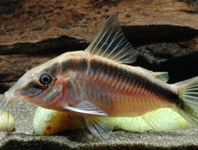Abstract
Nyctimantis galeata (Pombal, Menezes, Fontes, Nunes, Rocha & Van Sluys) is a casque-headed frog member of the Lophyohylini tribe (Blotto et al. 2020), narrow-endemic to the municipality of Morro do Chapéu, Bahia state, Brazil (Pombal et al. 2012). This species was initially described as sister of Corythomantis greeningi Boulenger based on shared osteological autapomorphies within Hylidae (see Faivovich et al. 2005; Pombal et al. 2012). However, in the most recent molecular phylogenetic analysis of Lophyohylini, Blotto et al. (2020) redefined the genus Nyctimantis to accommodate species from the former genus Aparasphenodon, Argenteohyla and “Corythomantis galeata” (as initially described; Pombal et al. 2012). Currently, the genus Nyctimantis comprises seven species: N. arapapa (Pimenta, Napoli & Haddad), N. bokermanni (Pombal), N. brunoi (Miranda-Ribeiro), N. galeata, N. pomba (Assis, Santana, Silva, Quintela & Feio), N. rugiceps Boulenger, and N. siemersi (Mertens). Among these, N. arapapa (Lourenço-de-Moraes et al. 2013), N. brunoi (Wogel et al. 2006) and N. siemersi (Céspedez 2000; Cajade et al. 2010) have their tadpoles described, while oral cavity anatomy was only reported for those of N. brunoi and N. siemersi (Wogel et al. 2006; Cajade et al. 2010). Considering that larval morphology generally provides reliable information for anuran systematic and taxonomic studies (Wassersug 1980; McDiarmid & Altig 1999; Haas 2003), a formal comparison of these larvae might highlight additional non-molecular evidence that support them as congeners (Blotto et al. 2020). Herein, we describe the external morphology and oral cavity anatomy of tadpoles of N. galeata and compare it with those of related species.
References
Altig, R. & Johnston, G.F. (1989) Guilds of anuran larvae: relationships among developmental modes, morphologies, and habitats. Herpetological Monographs, 3, 81–109.
https://doi.org/10.2307/1466987
Altig, R. & McDiarmid, R.W. (1999) Body Plan: Development and Morphology. In: McDiarmid, R.W. & Altig, R. (Eds.) Tadpoles: The Biology of Anuran Larvae. The University of Chicago Press, Chicago, Illinois, pp. 24–51.
Blotto, B.L., Lyra, M.L., Cardoso, M.C.S., Rodrigues, M.T., Dias, I.R., Marciano-Jr, E., Vechio, F.D., Orrico, V.G.D., Brandão, R.A., Assis, C.L., Lantyer-Silva, A.S.F., Rutherford, M.G., Gagliardi-Urrutia, G., Solé, M., Baldo, D., Nunes, I., Cajade, R., Torres, A., Grant, T., Jungfer, K.H., Silva, H.R., Haddad, C.F.B. & Faivovich, J. (2020) The phylogeny of the casque-headed treefrogs (Hylidae: Hylinae: Lophyohylini). Cladistics, 1–37. [early view]
https://doi.org/10.1111/cla.12409
Cajade, R., Schaefer, E.F., Duré, M.I., Kehr, A.I. & Marangoni, F. (2010) Reproductive biology of Argenteohyla siemersi pederseni Williams and Bosso, 1994 (Anura: Hylidae) in northeastern Argentina. Journal of Natural History, 44, 1953–1978.
https://doi.org/10.1080/00222931003642590
Céspedez, J.A. (2000) Historia natural de la rana de Pedersen Argenteohyla siemersi pederseni (Anura: Hylidae), y descripción de su larva. Boletín de la Asociación Herpetológica Española, 11, 75–80.
Dias, I.R., Silva, G.T., Solé, M. & Mira-Mendes, C.V. (2020) The advertisement call of the rare casque-headed frog Nyctimantis galeata (Anura: Hylidae) from its type locality, Morro do Chapéu, Bahia, Brazil. Zootaxa, 4853 (3), 447–450.
https://doi.org/10.11646/zootaxa.4853.3.8
Dubeux, M.J.M., Nascimento, F.A.C., Lima, L.R., Magalhães, F.M., Silva, I.R.S., Gonçalves, U., Almeida, J.P.F., Correia, L.L., Garda, A.A., Mesquita, D.O., Rossa-Feres, D.C. & Moti, T. (2020) Morphological characterization and taxonomic key of tadpoles (Amphibia: Anura) from the northern region of the Atlantic Forest. Biota Neotropica, 20, e20180718.
https://doi.org/10.1590/1676-0611-BN-2018-0718
Faivovich, J., Haddad, C.F.B., Garcia, P.C.A., Frost, D.R., Campbell, J.A. & Wheeler, W.C. (2005) Systematic review of the frog family Hylidae, with special reference to Hylinae: phylogenetic analysis and taxonomic revision. Bulletin of the American Museum of Natural History, 294, 1–240.
https://doi.org/10.1206/0003-0090(2005)294[0001:SROTFF]2.0.CO;2
Gosner, K.L. (1960) A simplified table for staging anuran embryo and larvae with notes on identification. Herpetologica, 16, 183–190.
Haas, A. (2003) Phylogeny of frogs as inferred from primarily larval characters (Amphibia: Anura). Cladistics, 19, 23–89.
https://doi.org/10.1111/j.1096-0031.2003.tb00405.x
Juncá, F.A., Carneiro, M.C.L. & Rodrigues, N.N. (2008) Is a dwarf population of Corythomantis greeningi Boulenger, 1896 (Anura, Hylidae) a new species? Zootaxa, 1686 (1), 48–56.
https://doi.org/10.11646/zootaxa.1686.1.4
Lourenço-de-Moraes, R., Lantyer-Silva, A.S.F., Toledo, L.F. & Solé, M. (2013) Tadpole, oophagy, advertisement call, and geographic distribution of Aparasphenodon arapapa Pimenta, Napoli and Haddad 2009 (Anura, Hylidae). Journal of Herpetology, 47, 575–579.
https://doi.org/10.1670/11-326
McDiarmid, R.W. & Altig, R. (1999) Tadpoles: The Biology of Anuran Larvae. The University of Chicago Press, Chicago, Illinois, 337 pp.
Pombal-Jr., J.P., Menezes, V.A., Fontes, A.F., Nunes, I., Rocha, C.F.D. & Sluys, M.V. (2012) A second species of the casque-headed frog genus Corythomantis (Anura, Hylidae) from Northeastern Brazil, the distribution of C. greeningi, and comments on the genus. Boletim do Museu Nacional, 530, 1–14.
Sherratt, E., Anstis, M. & Keogh, J.S. (2018) Ecomorphological diversity of Australian tadpoles. Ecology and Evolution, 8, 12929–12939.
https://doi.org/10.1002/ece3.4733
Schneider, C.A., Rasband, W.S. & Eliceiri, K.W. (2012) NIH Image to ImageJ: 25 years of image analysis. Nature Methods, 9, 671–675.
https://doi.org/10.1038/nmeth.2089
Wassersug, R.J. (1976) Oral morphology of anuran larvae: terminology and general description. Occasional Papers of the Museum of Natural History, University of Kansas, 48, 1–23.
Wassersug, R.J. (1980) Internal oral features of larvae from eight anuran families: functional, systematic, evolutionary and ecological considerations. Miscellaneous Publication of the University of Kansas, 68, 1–146.
https://doi.org/10.5962/bhl.title.16230
Wogel, H., Weber, L.N. & Abrunhosa, P.A. (2006) The tadpole of the casque-headed frog, Aparasphenodon brunoi Miranda-Ribeiro (Anura: Hylidae). South American Journal of Herpetology, 1, 54–60.
https://doi.org/10.2994/1808-9798(2006)1[54:TTOTCF]2.0.CO;2


